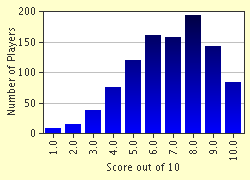Quiz Answer Key and Fun Facts
1. The B-17 had how many engines?
2. The B-17 "G" model had what feature, that distinguished it from previous models?
3. The "Memphis Belle" was what model B-17?
4. The B-17's precision bombing was mainly credited to what?
5. The B-17's main landing gear did what?
6. The B-17's Flight Engineer also had what job?
7. The B-17's "nose" was manned by what 2 crewmen?
8. B-17s were assembled by what plant?
9. After WW2 most B-17s were scrapped where?
10. High altitude bombing was made possible by what?
Source: Author
uphill50
This quiz was reviewed by FunTrivia editor
bloomsby before going online.
Any errors found in FunTrivia content are routinely corrected through our feedback system.


